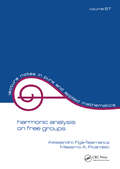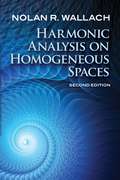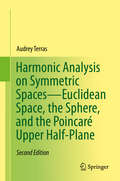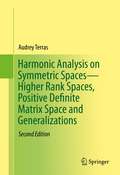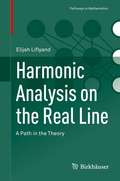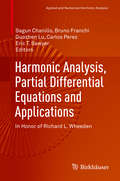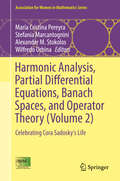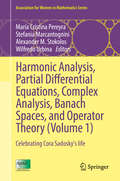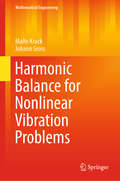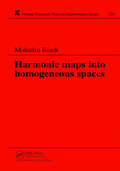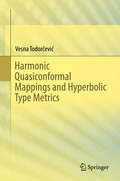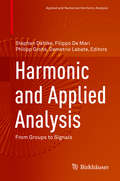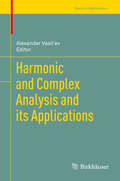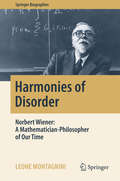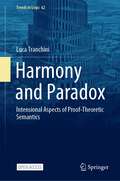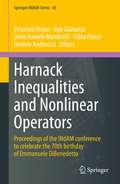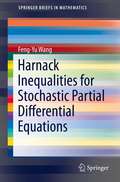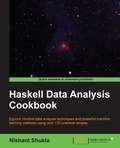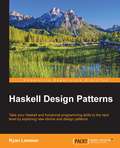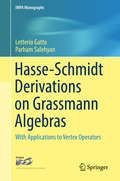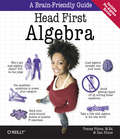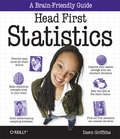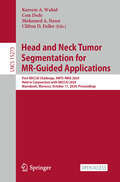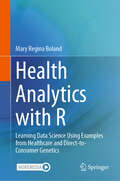- Table View
- List View
Harmonic Analysis on Free Groups
by Alessandro Figa-TalamancaThis book presents an account of recent results on the theory of representations and the harmonic analysis of free groups. It emphasizes the analogy with the theory of representations of noncompact semisimple Lie groups and restricts the focus to a class of irreducible unitary representations.
Harmonic Analysis on Homogeneous Spaces: Second Edition (Dover Books on Mathematics)
by Nolan R. WallachThis book is suitable for advanced undergraduate and graduate students in mathematics with a strong background in linear algebra and advanced calculus. Early chapters develop representation theory of compact Lie groups with applications to topology, geometry, and analysis, including the Peter-Weyl theorem, the theorem of the highest weight, the character theory, invariant differential operators on homogeneous vector bundles, and Bott's index theorem for such operators. Later chapters study the structure of representation theory and analysis of non-compact semi-simple Lie groups, including the principal series, intertwining operators, asymptotics of matrix coefficients, and an important special case of the Plancherel theorem.Teachers will find this volume useful as either a main text or a supplement to standard one-year courses in Lie groups and Lie algebras. The treatment advances from fairly simple topics to more complex subjects, and exercises appear at the end of each chapter. Eight helpful Appendixes develop aspects of differential geometry, Lie theory, and functional analysis employed in the main text.
Harmonic Analysis on Symmetric Spaces--Euclidean Space, the Sphere, and the Poincaré Upper Half-Plane
by Audrey TerrasThis unique text is an introduction to harmonic analysis on the simplest symmetric spaces, namely Euclidean space, the sphere, and the Poincaré upper half plane This book is intended for beginning graduate students in mathematics or researchers in physics or engineering Written with an informal style, the book places an emphasis on motivation, concrete examples, history, and, above all, applications in mathematics, statistics, physics, and engineering. Many corrections and updates have been incorporated in this new edition. Updates include discussions of P. Sarnak and others' work on quantum chaos, the work of T. Sunada, Marie-France Vignéras, Carolyn Gordon, and others on Mark Kac's question "Can you hear the shape of a drum?", A. Lubotzky, R. Phillips and P. Sarnak's examples of Ramanujan graphs, and, finally, the author's comparisons of continuous theory with the finite analogues. Topics featured throughout the text include inversion formulas for Fourier transforms, central limit theorems, Poisson's summation formula and applications in crystallography and number theory, applications of spherical harmonic analysis to the hydrogen atom, the Radon transform, non-Euclidean geometry on the Poincaré upper half plane H or unit disc and applications to microwave engineering, fundamental domains in H for discrete groups Γ, tessellations of H from such discrete group actions, automorphic forms, and the Selberg trace formula and its applications in spectral theory as well as number theory.
Harmonic Analysis on Symmetric Spaces—Higher Rank Spaces, Positive Definite Matrix Space and Generalizations
by Audrey TerrasThis text is an introduction to harmonic analysis on symmetric spaces, focusing on advanced topics such as higher rank spaces, positive definite matrix space and generalizations. It is intended for beginning graduate students in mathematics or researchers in physics or engineering. As with the introductory book entitled "Harmonic Analysis on Symmetric Spaces - Euclidean Space, the Sphere, and the Poincaré Upper Half Plane, the style is informal with an emphasis on motivation, concrete examples, history, and applications. The symmetric spaces considered here are quotients X=G/K, where G is a non-compact real Lie group, such as the general linear group GL(n,P) of all n x n non-singular real matrices, and K=O(n), the maximal compact subgroup of orthogonal matrices. Other examples are Siegel's upper half "plane" and the quaternionic upper half "plane". In the case of the general linear group, one can identify X with the space Pn of n x n positive definite symmetric matrices.Many corrections and updates have been incorporated in this new edition. Updates include discussions of random matrix theory and quantum chaos, as well as recent research on modular forms and their corresponding L-functions in higher rank. Many applications have been added, such as the solution of the heat equation on Pn, the central limit theorem of Donald St. P. Richards for Pn, results on densest lattice packing of spheres in Euclidean space, and GL(n)-analogs of the Weyl law for eigenvalues of the Laplacian in plane domains. Topics featured throughout the text include inversion formulas for Fourier transforms, central limit theorems, fundamental domains in X for discrete groups Γ (such as the modular group GL(n,Z) of n x n matrices with integer entries and determinant ±1), connections with the problem of finding densest lattice packings of spheres in Euclidean space, automorphic forms, Hecke operators, L-functions, and the Selberg trace formula and its applications in spectral theory as well as number theory.
Harmonic Analysis on the Real Line: A Path in the Theory (Pathways in Mathematics)
by Elijah LiflyandThis book sketches a path for newcomers into the theory of harmonic analysis on the real line. It presents a collection of both basic, well-known and some less known results that may serve as a background for future research around this topic. Many of these results are also a necessary basis for multivariate extensions. An extensive bibliography, as well as hints to open problems are included. The book can be used as a skeleton for designing certain special courses, but it is also suitable for self-study.
Harmonic Analysis, Partial Differential Equations and Applications
by Eric T. Sawyer Sagun Chanillo Bruno Franchi Guozhen Lu Carlos PerezThis collection of articles and surveys is devoted to Harmonic Analysis, related Partial Differential Equations and Applications and in particular to the fields of research to which Richard L. Wheeden made profound contributions. The papers deal with Weighted Norm inequalities for classical operators like Singular integrals, fractional integrals and maximal functions that arise in Harmonic Analysis. Other papers deal with applications of Harmonic Analysis to Degenerate Elliptic equations, variational problems, Several Complex variables, Potential theory, free boundaries and boundary behavior of functions.
Harmonic Analysis, Partial Differential Equations, Banach Spaces, and Operator Theory (Volume #2)
by Alexander M. Stokolos Wilfredo Urbina María Cristina Pereyra Stefania MarcantogniniThis book is the second of a two volume series. Covering a range of subjects from operator theory and classical harmonic analysis to Banach space theory, this book features fully-refereed, high-quality papers exploring new results and trends in weighted norm inequalities, Schur-Agler class functions, complex analysis, dynamical systems, and dyadic harmonic analysis. Graduate students and researchers in analysis will find inspiration in the articles collected in this volume, which emphasize the remarkable connections between harmonic analysis and operator theory. A survey of the two weight problem for the Hilbert transform and an expository article on the Clark model to the case of non-singular measures and applications to the study of rank-one perturbations are included. The material for this volume is based on the 13th New Mexico Analysis Seminar held at the University of New Mexico, April 3-4, 2014 and on several special sections of the Western Spring Sectional Meeting at the University of New Mexico, April 4-6,2014. During the event, participants honored the memory of Cora Sadosky--a great mathematician who recently passed away and who made significant contributions to the field of harmonic analysis. Cora was an exceptional scientist and human being. She was a world expert in harmonic analysis and operator theory, publishing over fifty-five research papers and authoring a major textbook in the field. Participants of the conference include new and senior researchers, recent doctorates as well as leading experts in the area.
Harmonic Analysis, Partial Differential Equations, Complex Analysis, Banach Spaces, and Operator Theory (Volume #1)
by Alexander M. Stokolos Wilfredo Urbina María Cristina Pereyra Stefania MarcantogniniCovering a range of subjects from operator theory and classical harmonic analysis to Banach space theory, this book contains survey and expository articles by leading experts in their corresponding fields, and features fully-refereed, high-quality papers exploring new results and trends in spectral theory, mathematical physics, geometric function theory, and partial differential equations. Graduate students and researchers in analysis will find inspiration in the articles collected in this volume, which emphasize the remarkable connections between harmonic analysis and operator theory. Another shared research interest of the contributors of this volume lies in the area of applied harmonic analysis, where a new notion called chromatic derivatives has recently been introduced in communication engineering. The material for this volume is based on the 13th New Mexico Analysis Seminar held at the University of New Mexico, April 3-4, 2014 and on several special sections of the Western Spring Sectional Meeting at the University of New Mexico, April 4-6, 2014. During the event, participants honored the memory of Cora Sadosky--a great mathematician who recently passed away and who made significant contributions to the field of harmonic analysis. Cora was an exceptional mathematician and human being. She was a world expert in harmonic analysis and operator theory, publishing over fifty-five research papers and authoring a major textbook in the field. Participants of the conference include new and senior researchers, recent doctorates as well as leading experts in the area.
Harmonic Balance for Nonlinear Vibration Problems (Mathematical Engineering)
by Malte Krack Johann GrossThis monograph presents an introduction to Harmonic Balance for nonlinear vibration problems, covering the theoretical basis, its application to mechanical systems, and its computational implementation. Harmonic Balance is an approximation method for the computation of periodic solutions of nonlinear ordinary and differential-algebraic equations. It outperforms numerical forward integration in terms of computational efficiency often by several orders of magnitude. The method is widely used in the analysis of nonlinear systems, including structures, fluids and electric circuits. The book includes solved exercises which illustrate the advantages of Harmonic Balance over alternative methods as well as its limitations. The target audience primarily comprises graduate and post-graduate students, but the book may also be beneficial for research experts and practitioners in industry.
Harmonic Maps Into Homogeneous Spaces (Chapman And Hall/crc Research Notes In Mathematics Ser. #255)
by Malcolm BlackHarmonic maps and the related theory of minimal surfaces are variational problems of long standing in differential geometry. Many important advances have been made in understanding harmonic maps of Riemann surfaces into symmetric spaces. In particular, ""twistor methods"" construct some, and in certain cases all, such mappings from holomorphic data. These notes develop techniques applicable to more general homogeneous manifolds, in particular a very general twistor result is proved. When applied to flag manifolds, this wider viewpoint allows many of the previously unrelated twistor results for symmetric spaces to be brought into a unified framework. These methods also enable a classification of harmonic maps into full flag manifolds to be established, and new examples are constructed. The techniques used are mostly a blend of the theory of compact Lie groups and complex differential geometry. This book should be of interest to mathematicians with experience in differential geometry and to theoretical physicists.
Harmonic Quasiconformal Mappings and Hyperbolic Type Metrics
by Vesna TodorčevićThe book presents a research area in geometric function theory concerned with harmonic quasiconformal mappings and hyperbolic type metrics defined on planar and multidimensional domains. The classes of quasiconformal and quasiregular mappings are well established areas of study in this field as these classes are natural and fruitful generalizations of the class of analytic functions in the planar case. The book contains many concrete examples, as well as detailed proofs and explanations of motivations behind given results, gradually bringing the reader to the forefront of current research in the area. This monograph was written for a wide readership from graduate students of mathematical analysis to researchers working in this or related areas of mathematics who want to learn the tools or work on open problems listed in various parts of the book.
Harmonic and Applied Analysis
by Stephan Dahlke Filippo Mari Philipp Grohs Demetrio LabateThis contributed volume explores the connection between the theoretical aspects of harmonic analysis and the construction of advanced multiscale representations that have emerged in signal and image processing. It highlights some of the most promising mathematical developments in harmonic analysis in the last decade brought about by the interplay among different areas of abstract and applied mathematics. This intertwining of ideas is considered starting from the theory of unitary group representations and leading to the construction of very efficient schemes for the analysis of multidimensional data. After an introductory chapter surveying the scientific significance of classical and more advanced multiscale methods, chapters cover such topics as An overview of Lie theory focused on common applications in signal analysis, including the wavelet representation of the affine group, the Schrödinger representation of the Heisenberg group, and the metaplectic representation of the symplectic group An introduction to coorbit theory and how it can be combined with the shearlet transform to establish shearlet coorbit spaces Microlocal properties of the shearlet transform and its ability to provide a precise geometric characterization of edges and interface boundaries in images and other multidimensional data Mathematical techniques to construct optimal data representations for a number of signal types, with a focus on the optimal approximation of functions governed by anisotropic singularities. A unified notation is used across all of the chapters to ensure consistency of the mathematical material presented. Harmonic and Applied Analysis: From Groups to Signals is aimed at graduate students and researchers in the areas of harmonic analysis and applied mathematics, as well as at other applied scientists interested in representations of multidimensional data. It can also be used as a textbook for graduate courses in applied harmonic analysis.
Harmonic and Complex Analysis and its Applications
by Alexander Vasil'EvThis volume highlights the main results of the research performed within the network "Harmonic and Complex Analysis and its Applications" (HCAA), which was a five-year (2007-2012) European Science Foundation Programme intended to explore and to strengthen the bridge between two scientific communities: analysts with broad backgrounds in complex and harmonic analysis and mathematical physics, and specialists in physics and applied sciences. It coordinated actions for advancing harmonic and complex analysis and for expanding its application to challenging scientific problems. Particular topics considered by this Programme included conformal and quasiconformal mappings, potential theory, Banach spaces of analytic functions and their applications to the problems of fluid mechanics, conformal field theory, Hamiltonian and Lagrangian mechanics, and signal processing. This book is a collection of surveys written as a result of activities of the Programme and will be interesting and useful for professionals and novices in analysis and mathematical physics, as well as for graduate students. Browsing the volume, the reader will undoubtedly notice that, as the scope of the Programme is rather broad, there are many interrelations between the various contributions, which can be regarded as different facets of a common theme.
Harmonic and Subharmonic Function Theory on the Hyperbolic Ball
by Manfred StollThis comprehensive monograph is ideal for established researchers in the field and also graduate students who wish to learn more about the subject. The text is made accessible to a broad audience as it does not require any knowledge of Lie groups and only a limited knowledge of differential geometry. The author's primary emphasis is on potential theory on the hyperbolic ball, but many other relevant results for the hyperbolic upper half-space are included both in the text and in the end-of-chapter exercises. These exercises expand on the topics covered in the chapter and involve routine computations and inequalities not included in the text. The book also includes some open problems, which may be a source for potential research projects.
Harmonies of Disorder
by Leone MontagniniThis book presents the entire body of thought of Norbert Wiener (1894-1964), knowledge of which is essential if one wishes to understand and correctly interpret the age in which we live. The focus is in particular on the philosophical and sociological aspects of Wiener's thought, but these aspects are carefully framed within the context of his scientific journey. Important biographical events, including some that were previously unknown, are also highlighted, but while the book has a biographical structure, it is not only a biography. The book is divided into four chronological sections, the first two of which explore Wiener's development as a philosopher and logician and his brilliant interwar career as a mathematician, supported by his philosophical background. The third section considers his research during World War II, which drew upon his previous scientific work and reflections and led to the birth of cybernetics. Finally, the radical post-war shift in Wiener's intellectual path is considered, examining how he came to abandon computer science projects and commenced ceaseless public reflections on the new sciences and technologies of information, their social effects, and the need for responsibility in science.
Harmony and Paradox: Intensional Aspects of Proof-Theoretic Semantics (Trends in Logic #62)
by Luca TranchiniThis open access book investigates the role played by identity of proofs in proof-theoretic semantics. It develops a conception of proof-theoretic semantics as primarily concerned with the relationship between proofs (understood as abstract entities) and derivations (the linguistic representations of proofs). It demonstrates that identity of proof is a key both to clarify some —still not wholly understood— notions at the core of proof-theoretic semantics, such as harmony; and to broaden the range of the phenomena which can be analyzed using the tools of this semantic paradigm, so as to include for instance paradoxes.The volume covers topics such as the philosophical significance of different criteria of identity of proofs, and adequacy conditions for an intensional account of the notion of harmony. The author also examines the Prawitz-Tennant analysis of paradoxes by investigating on the one hand the prospectsof turning it into a theory of meaning for paradoxical languages, and on the other hand two distinct kinds of phenomena, first observed by Crabbe and Ekman, showing that the Tennant-Prawitz criterion for paradoxicality overgenerates. This volume is of interest to scholars in formal and philosophical logic.
Harnack Inequalities and Nonlinear Operators: Proceedings of the INdAM conference to celebrate the 70th birthday of Emmanuele DiBenedetto (Springer INdAM Series #46)
by Vincenzo Vespri Ugo Gianazza Dario Daniele Monticelli Fabio Punzo Daniele AndreucciThe book contains two contributions about the work of Emmanuele DiBenedetto and a selection of original papers. The authors are some of the main experts in Harnack’s inequalities and nonlinear operators. These papers are part of the contributions presented during the conference to celebrate the 70th birthday of Prof. Emmanuele DiBenedetto, which was held at “Il Palazzone” in Cortona from June 18th to 24th, 2017. The papers are focused on current research topics regarding the qualitative properties of solutions, connections with calculus of variations, Harnack inequality and regularity theory. Some papers are also related to various applications. Many of the authors have shared with Prof. DiBenedetto an intense scientific and personal collaboration, while many others have taken inspiration from and further developed his field of research. The topics of the conference are certainly of great interest for the international mathematical community.
Harnack Inequalities for Stochastic Partial Differential Equations
by Feng-Yu WangIn this book the author presents a self-contained account of Harnack inequalities and applications for the semigroup of solutions to stochastic partial and delayed differential equations. Since the semigroup refers to Fokker-Planck equations on infinite-dimensional spaces, the Harnack inequalities the author investigates are dimension-free. This is an essentially different point from the above mentioned classical Harnack inequalities. Moreover, the main tool in the study is a new coupling method (called coupling by change of measures) rather than the usual maximum principle in the current literature.
Haskell Data Analysis Cookbook
by Nishant ShuklaStep-by-step recipes filled with practical code samples and engaging examples demonstrate Haskell in practice, and then the concepts behind the code. This book shows functional developers and analysts how to leverage their existing knowledge of Haskell specifically for high-quality data analysis. A good understanding of data sets and functional programming is assumed.
Haskell Design Patterns
by Ryan LemmerIf you're a Haskell programmer with a firm grasp of the basics and are ready to move more deeply into modern idiomatic Haskell programming, then this book is for you.
Hasse-Schmidt Derivations on Grassmann Algebras
by Letterio Gatto Parham SalehyanThis book provides a comprehensive advanced linear algebra course based on the concept of Hasse-Schmidt derivations on a Grassmann algebra (an analogue of the Taylor expansion for real-valued functions), and shows how this notion provides a natural framework for many ostensibly unrelated subjects: traces of an endomorphism and the Cayley-Hamilton theorem, generic linear ODEs and their Wronskians, the exponential of a matrix with indeterminate entries (Putzer's method revisited), universal decomposition of a polynomial in the product of two monic polynomials of fixed smaller degree, Schubert calculus for Grassmannian varieties, and vertex operators obtained with the help of Schubert calculus tools (Giambelli's formula). Significant emphasis is placed on the characterization of decomposable tensors of an exterior power of a free abelian group of possibly infinite rank, which then leads to the celebrated Hirota bilinear form of the Kadomtsev-Petviashvili (KP) hierarchy describing the Plücker embedding of an infinite-dimensional Grassmannian. By gathering ostensibly disparate issues together under a unified perspective, the book reveals how even the most advanced topics can be discovered at the elementary level.
Head First Algebra: A Learner's Guide to Algebra I (Head First)
by Dan Pilone Tracey PiloneHaving trouble understanding algebra? Do algebraic concepts, equations, and logic just make your head spin? We have great news: Head First Algebra is designed for you. Full of engaging stories and practical, real-world explanations, this book will help you learn everything from natural numbers and exponents to solving systems of equations and graphing polynomials.Along the way, you'll go beyond solving hundreds of repetitive problems, and actually use what you learn to make real-life decisions. Does it make sense to buy two years of insurance on a car that depreciates as soon as you drive it off the lot? Can you really afford an XBox 360 and a new iPhone? Learn how to put algebra to work for you, and nail your class exams along the way.Your time is way too valuable to waste struggling with new concepts. Using the latest research in cognitive science and learning theory to craft a multi-sensory learning experience, Head First Algebra uses a visually rich format specifically designed to take advantage of the way your brain really works.
Head First Statistics: A Brain-Friendly Guide (Head First)
by Dawn GriffithsWouldn't it be great if there were a statistics book that made histograms, probability distributions, and chi square analysis more enjoyable than going to the dentist? Head First Statistics brings this typically dry subject to life, teaching you everything you want and need to know about statistics through engaging, interactive, and thought-provoking material, full of puzzles, stories, quizzes, visual aids, and real-world examples.Whether you're a student, a professional, or just curious about statistical analysis, Head First's brain-friendly formula helps you get a firm grasp of statistics so you can understand key points and actually use them. Learn to present data visually with charts and plots; discover the difference between taking the average with mean, median, and mode, and why it's important; learn how to calculate probability and expectation; and much more.Head First Statistics is ideal for high school and college students taking statistics and satisfies the requirements for passing the College Board's Advanced Placement (AP) Statistics Exam. With this book, you'll:Study the full range of topics covered in first-year statisticsTackle tough statistical concepts using Head First's dynamic, visually rich format proven to stimulate learning and help you retain knowledge Explore real-world scenarios, ranging from casino gambling to prescription drug testing, to bring statistical principles to lifeDiscover how to measure spread, calculate odds through probability, and understand the normal, binomial, geometric, and Poisson distributionsConduct sampling, use correlation and regression, do hypothesis testing, perform chi square analysis, and moreBefore you know it, you'll not only have mastered statistics, you'll also see how they work in the real world. Head First Statistics will help you pass your statistics course, and give you a firm understanding of the subject so you can apply the knowledge throughout your life.
Head and Neck Tumor Segmentation for MR-Guided Applications: First MICCAI Challenge, HNTS-MRG 2024, Held in Conjunction with MICCAI 2024, Marrakesh, Morocco, October 17, 2024, Proceedings (Lecture Notes in Computer Science #15273)
by Kareem A. Wahid Cem Dede Mohamed A. Naser Clifton D. FullerThis Open Access book constitutes the refereed proceedings of the First MICCAI Challenge, HNTSMRG 2024, Held in Conjunction with MICCAI 2024, in Marrakesh, Morocco, on October 17, 2024. The 20 full papers and 1 overview paper included in this volume were carefully reviewed and selected from a total of 21 submissions. The HNTS-MRG 2024 Challenge focuses on advancing clinical workflows by leveraging artificial intelligence (AI) for automated segmentation of tumor regions in multi-timepoint MRI scans.
Health Analytics with R: Learning Data Science Using Examples from Healthcare and Direct-to-Consumer Genetics
by Mary Regina BolandThis textbook teaches health analytics using examples from the statistical programming language R. It utilizes real-world examples with publicly available datasets from healthcare and direct-to-consumer genetics to provide learners with real-world examples and enable them to get their hands on actual data. This textbook is designed to accompany either a senior-level undergraduate course or a Masters level graduate course on health analytics. The reader will advance from no prior knowledge of R to being well versed in applications within R that apply to data science and health analytics. “I have never seen a book like this and think it will make an important contribution to the field. I really like that it covers environmental, social, and geospatial data. I also really like the coverage of ethics. These aspects of health analytics are often overlooked or deemphasized. I will definitely buy copies for my team.” - Jason Moore, Cedars-Sinai Medical Center “Overall, I have a highly positive impression of the book. It is VERY comprehensive. It covers very extensive data types. I do not recall other books with the same level of comprehensiveness.” - Shuangge Ma, Yale University “The book is comprehensive in both aspects of genetics, and health analytics. It covers any type of information a healthcare data scientist should be familiar with, whether they are novice or experienced. I found any chapter that I looked into comprehensive, but also not too detailed (although in general this book is more than 600 pages of comprehensive and detailed relevant information).” - Robert Moskovtich, Ben-Gurion University of the Negev
